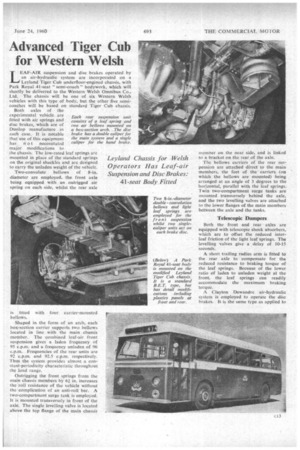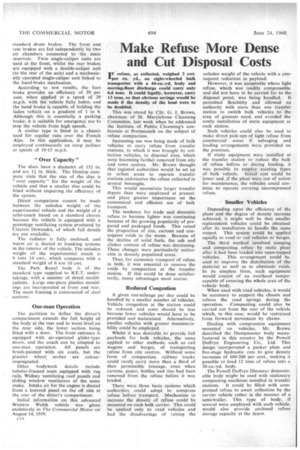Advanced Tiger Cub for Western Welsh
Page 51

Page 52

If you've noticed an error in this article please click here to report it so we can fix it.
LEAF-AIR suspension and disc brakes operated by an air-hydraulic system are incorporated on a Leyland Tiger Cub underfloor-engined chassis, with Park Royal 41-seat " semi-coach " bodywork, which will shortly be delivered to the Western Welsh Omnibus Co., Ltd. The chassis will be one of six Western Welsh vehicles with this type of body, but the other five semicoaches will be based on standard Tiger Cub chassis.
Both axles of the experimental vehicle are fitted with air springs and disc brakes, which are of Dunlop manufacture in each case. It is notable that use of this equipment has n 0 t necessitated major modifications to the chassis.The low-rated leaf springs arc mounted in place of the standard springs on the original shackles and arc designed to carry the unladen weight of the vehicle.
Two-convolute bellows of 8-in. diameter are employed, the front axle being equipped with an outrigged air spring on each side, whilst the rear axle is fitted with four carrier-mounted bellows.
Shaped in the form of an arch, each box-section carrier supports two bellows located in line with the main chassis member. The combined leaf-air front suspension gives a laden frequency of 95 c.p.m. and a frequency unladen of 96 c.p.m. .Frequencies of the rear units are 92 c.p.m. and 92.5 c.p.m. respectively. Thus the system provides almost a constant-periodicity characteristic throughout the load range.
Outrigging the front springs from the main chassis members by 6* in. increases the roll resistance of the vehicle without the complication of an anti-roll bar. A two-compartment surge tank is employed. It is mounted transversely in front of the axle. The single levelling valve is located above the top flange of the main chassis
member on the near side, and is linked to a bracket on the rear of the axle.
The bellows carriers of the rear suspension are attached direct to the main members, the feet of the carriers .(on which the bellows are mounted) being arranged at an angle of 3 degrees to the horizontal, parallel with the leaf springs. Twin two-compartment surge tanks are mounted transversely behind the axle, and the two levelling valves are attached to the lower flanges of the main members between the axle and the tanks.
Telescopic Dampers
Both the front and rear axles are equipped with telescopic shock absorbers, which are to offset the reduced interleaf friction of the light leaf springs. The levelling valves give a delay of 10-15 seconds.
A short trailing radius arm is fitted to the rear axle to compensate for the reduced resistance to braking torque of the leaf springs. Because of the lower ratio of laden to unladen weight at the front, the leaf springs can readily accommodate the maximum braking torque.
A Clayton Dewandre air-hydraulic system is employed to operate the disc brakes. It is the same type as applied to standard drum brakes, The front and rear brakes are fed independently by two air chambers connected to the main reservoir. Twin single-caliper units are used at the front, whilst the rear brakes are equipped with a double-caliper unit (to the rear of the axle) and a mechanically operated single-caliper unit linked to the hand-brake mechanism, According to test results, the foot brake provides an efficiency of 59 per cent. when applied at a speed of 20 m.p.h. with the vehicle fully laden, and the hand brake is capable of holding the laden vehicle on a gradient of I in 4. Although this is essentially a parking brake, it is suitable for emergency use to stop the vehicle from high speeds.
A similar type is fitted to a chassis used for regular runs over the French Alps. In this application, it may be employed continuously on steep inclines at speeds of 10-15 m.p.h.
"Over Capacity"
The discs have a diameter of 151 in.
and are in. thick. The Dunlop cornpuny state that the size of the disc is over capacity" for the weight of the vehicle and that a smaller disc could. he fitted without impairing the efficiency of the system.
Direct comparison cannot be made between the unladen weight of the experimental vehicle and the weight of a semi-coach based on a standard chassis because the vehicle is equipped with a prototyRe ventilating system produced by Clayton Dewandre, of which full details are not available.
The radiator is fully enclosed, and warm air is ducted to trunking systems in the interior of the vehicle, The unladen weight of the experimental coach is 6 tons 14 cwt., which compares with a standard weight of 6 ton 10 cwt.
The Park Royal body is of the standard type supplied to B.E.T. undertakings, with a number of detail. modifications. Large one-piece plastics mouldings are incorporated at front and rear. The main framing is constructed of steel sections.
One-man Operation The partition to define the driver's compartment extends the full height of the body at the rear and to waist level. on the near side, the lower section being fitted with a door. The front entrance is equipped with air-operated glider-type doors, and the coach can be adapted to one-man operation. All panels are brush-painted with six coats, but the plastics wheel arches are colourimpregnated.
Other bodywork details include tubular-framed seats equipped with rug rails, Widney ventilating roof panels and sliding window ventilators of the same make. Intake air for the engine is ducted from a louvred panel on the off side at the rear of the driver's compartment.
Initial information on this advanced Western Welsh vehicle was given exclusively in The Commercial Motor on August 14, 1959.












































































































